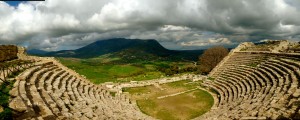
In Segesta we also visited the remains of an ancient theater, situated on the hilltop just beyond the unfinished temple. Originally constructed by Sicilian Greeks, the theater is carved within the hillside, utilizing the natural declining slope of the ridge to its own advantage. In this way, the theater wonderfully conforms to the surrounding landscape and is very much in harmony with the topography of the region. In later periods, the theater was used by the Romans, who, unlike the Greeks, sought to dominate the landscape through their superior engineering. This difference is best highlighted by the use of the scene frons, which was the decorated, architectural background of a Roman theater stage. The scaenae frons was a permanent, often elaborate structure that stretched multiple stories into the sky. This building was influenced by the much simpler, Greek equivalent known as the skene, which was not permanent and typically only one story tall. It was incredible to think that such a structure as the scaeneae frons would completely block out the breathtaking view that we enjoyed as we sat in the theater seats.